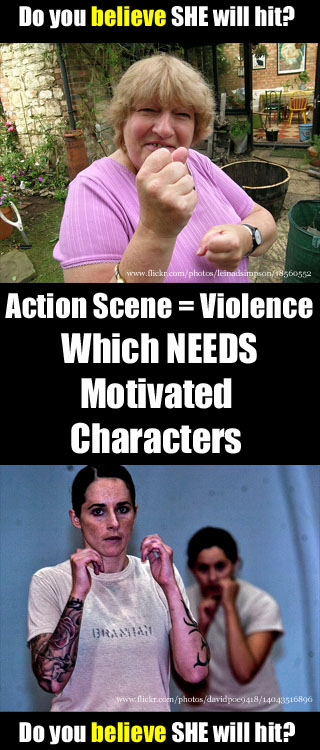 In my current WIP, I want to up the action and make this a physically exciting story. So, I bought a great ebook, Action! Writing Better Action Using Cinematic Techniques by Ian Thomas Healy. It’s great, as I said, and breaks down the actions into easy components that can be easily mastered. Even for me, it’s easy.
In my current WIP, I want to up the action and make this a physically exciting story. So, I bought a great ebook, Action! Writing Better Action Using Cinematic Techniques by Ian Thomas Healy. It’s great, as I said, and breaks down the actions into easy components that can be easily mastered. Even for me, it’s easy.
Healy says that great action scenes put characters into motion and the “effective description of that motion is what makes the difference. . .”
I get that part. But here’s what stumps me: “At its most basic level, an action scene is an expression of plot or character development through violence.”
Violence. As in people hitting each other, shooting at each other, killing each other. Yep. That kind of physical violence.
It’s been a long, long time since I was in a knock-down drag-out fight. That was with my younger brother when I was about 15, and we were fighting about whether the overhead light was on or off while we watched TV. I never had the chance to play football, which is a pure Show-Don’t-Tell version of testosterone. When my daughters played soccer, I cringed when they played tea party on the field: Oh, you have the ball? Well, take your turn and when you are finished, I’ll take my turn. Teaching aggression (much less violence) to young ladies is hard.
Our society trains women to avoid violence. We teach our daughters aggression now on a soccer field, but step off the field and it’s tea party time again. Women writers are at a disadvantage in writing action scenes.
Because Healy says that a great action scene needs violence.
Heck, I can’t even work up a good case of Road Rage.
Motivation. The hardest thing for me is to motivate the characters. I can block out the action and get the characters fighting. I’ve seen enough action movies to be able to do it. (Go watch The Transformers latest movie if you want non-stop violence. Wow. It must take up 75% of that movie.)
But WHY are these characters resorting to violence? (See, even our language makes it hard to use violence: “resort” implies that violence is a last option and the choice to use it is not easy.) Why would the characters use fists, swords, guns or other weapons against someone else? Healy helps with blocking out the sequences of actions and building them into longer sequences. But he says little about the character motivations.
In one sense, this is an escalating of tensions. Almost any motivation would work: revenge, for example, could easily escalate into violence. Two rivals for a fortune in gold could escalate an argument into violence and death. For violence to take place, there’s a line that needs to be crossed. Polite society demands that people restrain themselves, and that self-control must break for your characters, shoving them into a no-holds-barred action. Violence. It’s an escalation and it’s a letting go of social restraints. It’s a willingness to take action and a determination to get something done—no matter what.
Sounds like a good way to increase the tension and stakes in a story. Yes, often action stories are physical stories, without much in the way of characterization. You’ve heard it said that you either write an action story or you write a character story. A cross-pollination though, could create an intriguing mix. This time, I’m shooting for a story with better balance between action and character.
Cinematic. In some ways, this mix will be more cinematic. The sights and sounds of the action are crucial to the success of the scene. And yes, as I am writing, I am trying to visualize the actions in my head; I’m trying to see it as if it is on the big screen. Healy’s title is right on, violence—action scenes—are cinematic.
Thanks to Healy’s advice, I am making lists of what he calls “stunts,” or isolated pieces of actions, that will build into “engagements,” or movement across a setting, which will ultimately build toward some climactic “resolution.” I am taking baby steps in building a chapter with interesting action, um, violence.
Look out. I’m strapping on my boxing gloves, er, getting ready to type the next chapter of this new action-adventure story.